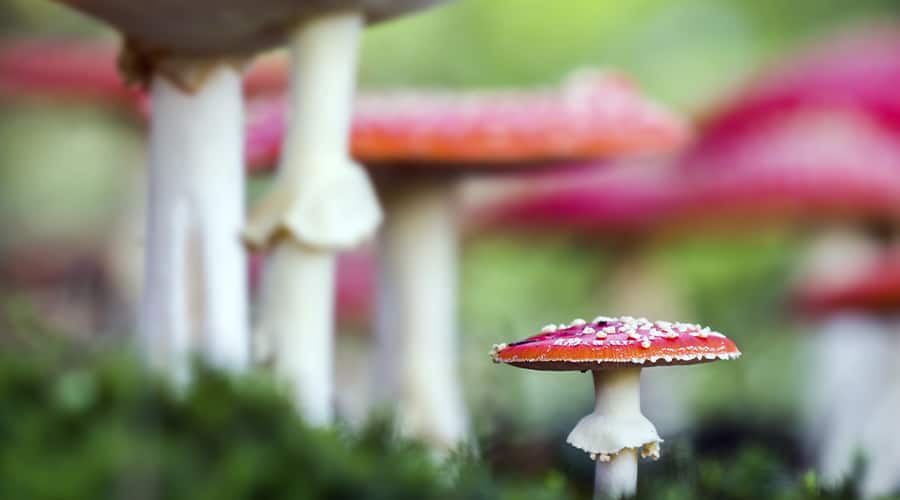If you’re a mycologist looking for a real challenge, learning how to grow Amanita muscaria ticks plenty of boxes. Also known as the fly agaric, this mushroom is native to boreal and temperate regions of the northern hemisphere. Widely found in North America and Europe, amanita was also introduced to South Africa, Australia, and New Zealand.
Thus, if you live in a suitable region and know something about foraging, you should be able to source this mushroom naturally. However, if amanita doesn’t grow near you, or you’re not confident in your foraging skills, growing the mushroom may seem like an appealing alternative.
There are varying accounts regarding the likelihood of successfully growing amanita. In this article, I outline if it is even possible and discuss useful harvesting techniques and storage methods.

VidaCap can send its delicious amanita gummies to your home. It only takes a few clicks, and you get to enjoy tasty Berry-Mango gummies containing decarbed amanita extract. So, you don’t need to go into the wild when you can bring the fly agaric to you.
Where Does Amanita Muscaria Normally Grow?
As a mycorrhizal fungus, amanita has a strong association with trees. As a result, you’ll find most amanita growing in forests or woodlands. This mushroom loves the rich soil on the floors of northern hemisphere forests and grassy regions. It is mainly linked with pine trees, and its mycelia (the vegetative parts of a fungus) reside within the tree’s roots.

Apart from the pine, amanita has a symbiotic relationship with cedar, fir, birch, oak, and spruce trees. You’re in luck if you live in New Zealand or the Australian territories of Victoria or Tasmania, as Amanita muscaria grows readily in these regions.
Yet, it is important to note that the genus Amanita consists of approximately 600 species of agarics. Indeed, it is the genus associated with around 95% of all mushroom poisonings! The infamous Amanita phalloides, also known as the “death cap” is the mushroom responsible for most cases of poisoning.
So, if you cannot differentiate between the varying types of forest amanita, you might consider growing Amanita muscaria yourself.
Indoor Amanita Muscaria Growing: Realistic or Fantasy?
A quick Google search will reveal plenty of information about Amanita muscaria indoor cultivation. When you type in the question: “Can you grow Amanita muscaria indoors?” you may even find articles that claim it’s possible.
Such content is usually little more than clickbait and serves no useful purpose. That’s because growing Amanita muscaria indoors is virtually impossible. One study, which involved creating amanita mycelium in a laboratory, found that no mushrooms were produced, and the mycelium grew at a glacial pace.
As far as experts know, no one has ever successfully grown Amanita muscaria indoors.
What About Growing Amanita Muscaria Outdoors?
The outlook is slightly better if you want to discover how to grow Amanita muscaria outdoors. By that, I mean it is theoretically possible, although, once again, there is no concrete evidence that anyone has managed it.
For readers intending to be the first, here’s a guide to how you could go about the process.
What’s Required for Outdoor Amanita Growing?
First and foremost, remember that this is a complete case of trial and error, and you will fail continuously. Hopefully, that sentence isn’t as off-putting as it sounds!
Some people believe you can use potting soil, a combination of peat moss and perlite. Such soil needs exceptional drainage since amanita hates standing water. However, while this may work with other mushrooms, it’s unlikely to prove effective with Amanita muscaria, as it is fussier.
In reality, it’s all about finding a suitable tree to serve as a “home” for the fly agaric. While pine trees are arguably the best option, using birch as a second prize is okay. Oak, cedar, fir, and spruce may work in a pinch.
Please note that you may need to find private land, which necessitates getting the owner’s permission.
Once you find a suitable tree, the next step is to create a “slurry” comprised of amanita spores and water. Spread it around the tree in an area shaded from direct sunlight with reasonable drainage. Water the amanita patch every two weeks if there hasn’t been much rainfall.
Additional Information
As far as temperature is concerned, the “optimal” range is purportedly between 50- and 68-degrees Fahrenheit (10 to 20 degrees Celsius). While it can tolerate a slightly cooler climate, higher temperatures hinder growth and possibly kill the mycelium. So, if you live in a warm region, you probably won’t have much luck.
Amanita also prefers slightly acidic soil with a pH between 5.5 and 7.0, deemed suitable.
I don’t want to rain on your parade, but even if mycelium is established, you can expect to wait years for mushrooms to start growing!
How to Forage for Amanita
Given the difficulty (some would say near impossibility) of growing the fly agaric, you may want to learn more about foraging it instead. Although it has a distinctive appearance, sourcing Amanita muscaria isn’t necessarily easy.
First of all, as mentioned earlier, hundreds of mushrooms are within the Amanita genus. Secondly, some of them are poisonous. Thirdly, it is illegal to forage in many national parks.
When foraging, remember that the fly agaric tends to appear between August and November. It is best to use the trees discussed earlier, particularly pine and birch. Triple-check any mushroom you pick to ensure it is the right one. If you’re in any doubt, leave it be!
Harvesting Amanita Muscaria the Right Way
Once you’re confident in your ability to correctly identify mushrooms, it’s time to learn how to harvest Amanita muscaria. It’s pretty easy once you get used to the process.
Before harvesting Amanita muscaria, have gloves, a sharp, clean knife, and tongs or tweezers. You want to avoid touching the mushrooms with your hands.

Option one is to take hold of the swollen base of the fly agaric and twist it hard enough to detach from the mycelium. Option two is to use the knife to cut the mushroom as close to the ground as you can.
Timing is fairly important when collecting an Amanita muscaria harvest. As a general rule of thumb, fly agaric mushrooms are more potent early in the growing season. Therefore, you may want to harvest them in August or September. Then again, this is not set in stone, as potency can vary depending on the geographical region and even the year.
How to Store Amanita Mushrooms
Your mission is far from complete at this stage! Proper Amanita muscaria storage and drying are essential for keeping them fresh. Ideally, you’ll put them in a paper bag to stop moisture from building up and use them within a few days.
If you plan to keep the mushrooms longer, you must dry them. Drying amanita involves spreading them on cardboard or a dry towel in a well-ventilated area. Once the fly agaric feels a little rubbery, it’s time to dry them more thoroughly.
Popular options include air drying, using a dehydrator, and oven drying. You may also want to use a desiccant to ensure your amanita is extra dry.
It’s time to place them in an airtight glass container at this stage. Store the mushrooms away from direct sunlight at a temperature of between 50- and 60-degrees Fahrenheit.

VidaCap can send its delicious amanita gummies to your home. It only takes a few clicks, and you get to enjoy tasty Berry-Mango gummies containing decarbed amanita extract. So, you don’t need to go into the wild when you can bring the fly agaric to you.
Growing Amanita Muscaria: The Last Word
While you’re free to try and grow amanita, your likelihood of succeeding is slim. If you have evidence of a successful Amanita muscaria grow, please send it in!
Given the challenges of growing the mushroom, you’re better off learning how to forage for amanita and the best harvesting and storage methods. If this seems too much effort, you can purchase pre-dried mushrooms and products like amanita gummies online. Make sure you use a reputable seller, as the industry is poorly regulated.










